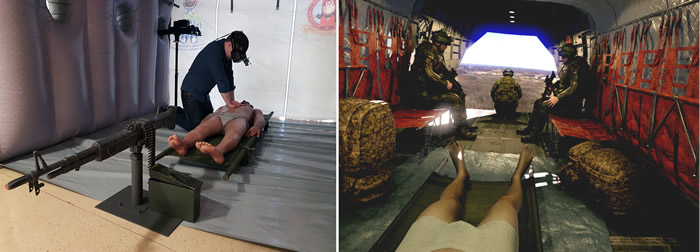VR and AR chinook training for military medics
A simulator of a Chinook helicopter, bringing together VR and an inflatable enclosure, has been conceived to help to support the future training of the UK Armed Forces’ Medical Emergency Response Team (MERT). The University of Birmingham’s Human Interface Technology (HIT) team designed the high-tech solution to help medical personnel to train for battlefield incidents that require emergency medicine, often administered in the back of the helicopter.
MERT consist of a number of highly trained medical personnel and include consultants in emergency medicine or anesthesia, emergency nurses and paramedics, providing hospital level trauma care in the back of helicopter, resuscitating and stabilizing casualties and bringing them back to the deployed Field Hospital.
Professor Col Peter Mahoney, Consultant Anaesthetist at the Royal Centre for Defence Medicine said, “The intent behind this ground-breaking research project is for us to exploit cutting edge technologies and thinking to offer Defense Medical Services an agile and cost effective training option for future deployments”.
Professor Bob Stone, HIT team Director from the University of Birmingham, and Research Fellow Dr Robert Guest, the team’s Lead Simulation Developer, observed MERT training at RAF Brize Norton.
Professor Stone explained, “As we were watching the trainee medics loading, unloading and interacting with simulated bodies, all within a mock-up of a Chinook cabin, it became very clear that this was no ordinary VR or AR project for us.
The way the teams communicated under conditions of stress and background noise, the cramped nature of the cabin, the range of medical equipment, the types of injuries experienced; all of these drove our decision to consider developing a very new Mixed Reality solution, blending the best of the virtual with actual physical elements representing the real.”
The project combines a representative human body, and inflatable ‘Chinook’ interior and Virtual and AR aspects.
Given the limitations in current virtual representations of human bodies, especially those with significant representation of trauma, the team decided that this element of the simulation had to be physical.
TraumaFX, a company based in North Yorkshire, delivered the Simbodie, an incredibly detailed human male model capable of being configured to represent a wide range of injuries, complete with interchangeable lower leg components representing intact limbs and traumatic amputation, and repositionable bullet wounds and lacerations.
A Leicestershire-based company, Imagine Inflatables, constructed a ‘Chinook’ enclosure capable of being inflated and deflated quickly for rapid deployment and portability.
Together with replica Minigun and M60 Machine Gun models, and in conjunction with the Simbodie, the enclosure provides a constraining environment for simulator users, offering sufficient real physical space to work in tandem with the Virtual and AR imagery to generate a believable in-flight scenario.
The early Virtual and AR imagery was produced by Dr Guest and, as well as using video to simulate the external view from the helicopter via the windows and rear ramp (captured by flying the HIT Team’s drones over Dartmoor). The scene has been integrated with realistic sound effects taken within an actual Chinook cabin, provided to the team by Boeing Defence UK.
Using an AR head-mounted display, trainees are able to experience interacting with a body that has both visual and haptic elements.
The position of head mounted display is tracked in real time, and in six degrees of freedom, using an OptiTrack V120 optical/infrared motion capture system. This same system is used to track the end user’s hands, using small infrared markers mounted on lightweight gloves.
Professor Stone added, “Although the current virtual cabin is nowhere near as dynamic as the real operational context, it is more than adequate for the purposes of demonstrating the proof of concept. The hope is that simulators such as this could be deployed quickly and effective to support the training of such a vital team.”
More information: University of Birmingham


Comments are closed, but trackbacks and pingbacks are open.